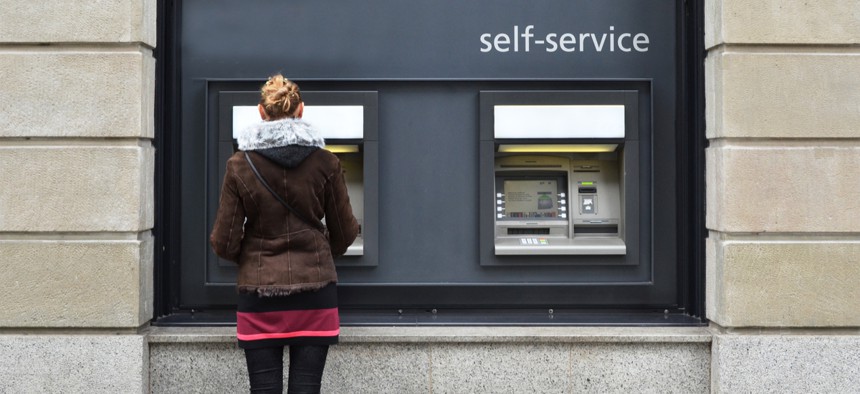How 10 Cities Are Testing What Works to Increase Economic Mobility

In Albuquerque, cities officials want to improve the financial health and literacy of young people by increasing their access to bank accounts and other financial empowerment services. Shutterstock/Capricorn Studio
COMMENTARY | City leaders are tapping into data to figure out policies that will improve the prospects of people struggling in communities across the country
If you scanned some of the financial headlines lately, you could be forgiven for thinking America had entered a new economic Golden Age. The economy is “roaring” (NBC News), “thriving” (Fox News) and even “too good to be true” (Washington Post).
You’d get a very different sense of the state of economic opportunity in America by talking to Mike and Willa Strickland of Dayton, Ohio. They were living with their boys in a homeless shelter until they found a spot in a public housing complex. Mike, a line worker at a meatpacking plant, recalled recently in a Frontline documentary how his parents were able to build a comfortable middle class life. He and his wife, who works in customer service, have struggled just to keep a roof over their heads.
The Stricklands’ story reflects what Harvard University economist Raj Chetty and his colleagues describe as the “fading American Dream.” While 90 percent of children born in the 1940s grew up to earn more than their parents, only half of children today will earn more than their parents. Millions of low-income young people are living in neighborhoods where their chances of climbing the economic ladder are slim.
While this data paints a darker picture of America than what's been captured in many of the recent monthly jobs reports, it also offers hope. If you can diagnose where economic mobility is declining down to the census tract and city block, you can also design better policies to address it. Visionary city leaders across the country are doing just that.
This week, 10 American cities are joining a new national initiative to use data to pinpoint barriers to opportunity for their residents, and to pilot interventions to help accelerate economic mobility in their communities. Most important, they will be collecting data to determine what works—and what doesn’t—to help put residents on a path toward upward mobility.
The cities range from Albuquerque, which will seek to improve the financial health and literacy of its youth by increasing their access to bank accounts and other financial empowerment services, to Cincinnati, which will work with employers to innovate and adopt practices that remove barriers for low-income workers to succeed at work and advance in their lives. Dayton will test innovative approaches to increasing parental engagement in early childhood education, while Detroit will help connect low-income residents in affordable housing units to programs and services that increase their economic opportunities and chances of achieving housing stability.
Lansing will seek to increase residents’ access to an array of financial empowerment tools, while Newark will tackle reducing eviction rates. New Orleans will try to engage young people in services that prepare them for successful careers, while Racine will help more adults obtain a high school equivalency diploma. Rochester will help income-eligible families weather financial shocks and build wealth through a matched savings program, while Tulsa will connect youth who are not currently in work or school with the education and training they need for high-quality jobs in the community.
With the support of three of the nation’s leading philanthropies—Bloomberg Philanthropies, the Bill & Melinda Gates Foundation and the Ballmer Group—the cities will implement these ideas and measure their impact, with technical assistance provided by experts at Results for America, the Behavioral Insights Team, Opportunity Insights and other What Works Cities partners.
Across the country, policymakers are hungry for new, more effective solutions. In Bloomberg Philanthropies’ 2018 American Mayors Survey, one of the top concerns raised by mayors and city managers was the challenge of providing more and better economic opportunities for all residents.
Before they invest limited taxpayer dollars, elected leaders want to see evidence that these programs and policies can move the needle and improve lives. By closely tracking the results of a diverse set of ideas, these 10 cities will provide valuable insights to communities nationwide.
Not every intervention will work. Some will need to be improved or supplemented with other services and supports. Others will show real promise in increasing economic mobility for children and families.
This was the same approach we took during the Obama Administration when we launched the Social Innovation Fund to invest in high-impact solutions and rigorously evaluate the results. The fund acted as a catalyst, helping social entrepreneurs test and scale ideas to fight childhood obesity, help first-generation college students graduate, improve health outcomes for people living with HIV, and much more.
It was the same approach former Mayor Mike Bloomberg developed in New York City, where city leaders piloted dozens of anti-poverty programs—doubling down on those that worked, improving or eliminating those that didn’t. In an era of rising inequality, those efforts helped reduce New York City’s poverty rate.
Progress is possible—even on our most intractable problems—if government leaders are courageous enough to test bold ideas and invest in what works.
Michele Jolin is the CEO and Co-Founder of Results for America, which helps policymakers use data and evidence to address the world’s greatest challenges. She served as senior advisor for social innovation at the White House under President Obama.
NEXT STORY: U.S. Sees Uptick in Manufacturing Jobs, But It’s Uneven Across Regions





